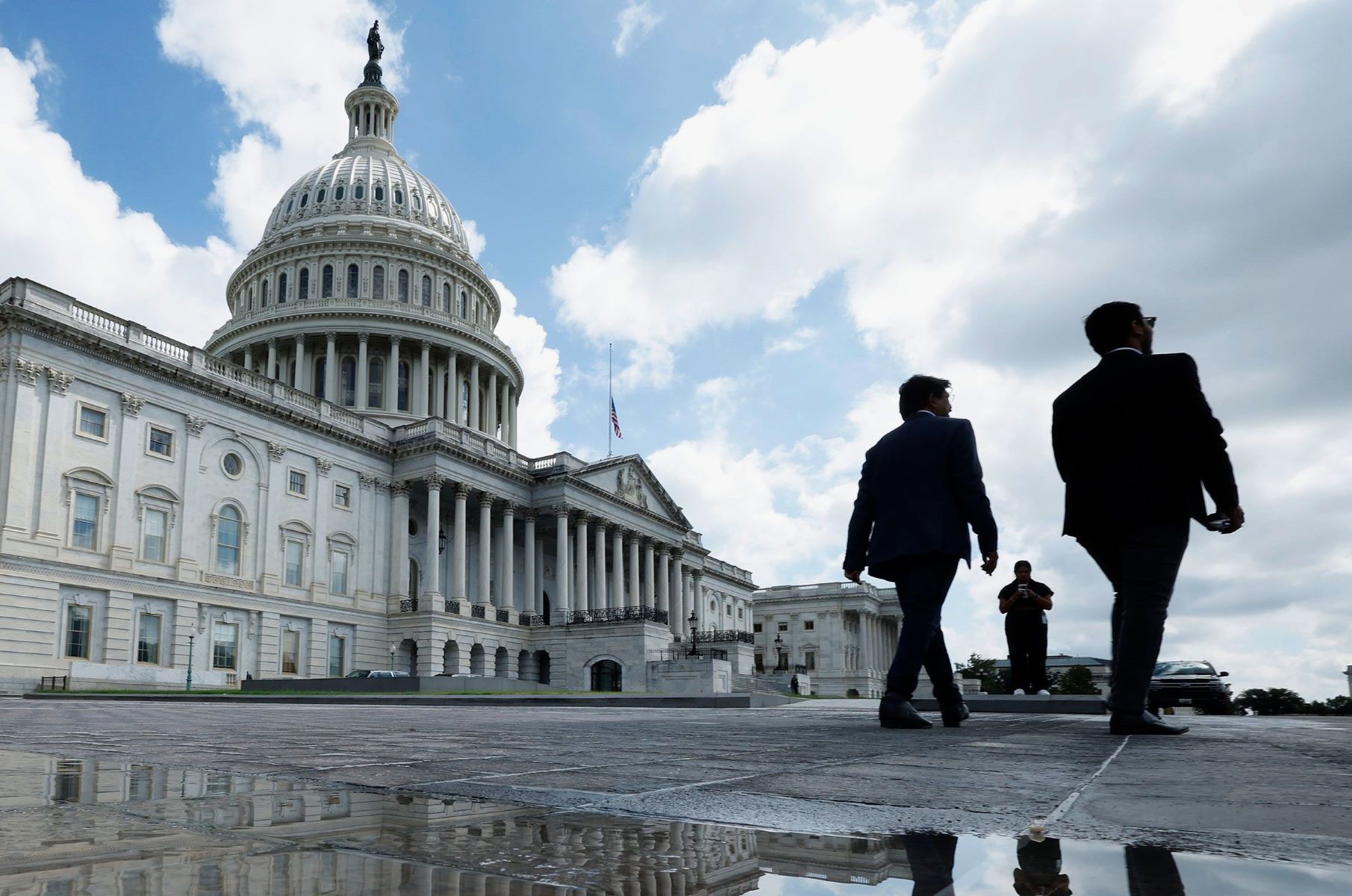
What happens when the U.S. government runs out of money? A government shutdown occurs, halting all non-essential federal activities until new funding is approved. Essential services like public safety and mandatory programs such as Social Security and Medicare continue. Shutdowns stem from disagreements between Congress and the President over spending. The first significant shutdown happened in 1995, lasting 26 days. The longest one, in 2018-2019, lasted 35 days. These shutdowns affect federal employees, the economy, and various services. Understanding the causes and impacts of government shutdowns helps us grasp their significance and the challenges they pose.
Key Takeaways:
- Government shutdowns halt non-essential federal services due to funding disagreements, impacting employees, the economy, and essential programs like Social Security and Medicare.
- Shutdowns erode public trust, disrupt scientific research, and delay regulatory approvals, affecting businesses, individuals, and essential services.
What is a Government Shutdown?
A government shutdown happens when federal agencies must stop all non-essential discretionary functions because funding legislation hasn't been enacted. Essential services continue, but many others grind to a halt.
-
Definition of a Government Shutdown: Federal agencies stop non-essential functions until new funding is passed and signed into law. Essential services like public safety keep running, and mandatory spending programs like Social Security and Medicare remain unaffected.
-
Causes of Government Shutdowns: Disagreements between Congress and the President over spending levels and policy issues cause shutdowns. The Anti-Deficiency Act of 1884 prohibits federal agencies from spending more than what is appropriated, leading to shutdowns when Congress fails to pass funding bills.
Historical Context of Government Shutdowns
Understanding the history of government shutdowns helps explain their causes and effects. The first shutdowns were brief, but some have lasted weeks.
-
First Government Shutdown: The first shutdown occurred in 1976, lasting only a few hours.
-
Prolonged Shutdowns: The first long shutdowns happened in 1995 and 1996 during the Clinton administration, lasting a total of 26 days due to disagreements over spending levels.
Effects of Government Shutdowns
Shutdowns affect federal employees, the economy, and various services. Here’s how:
-
Impact on Federal Workforce: Many civilian federal employees are furloughed, meaning they can't work or get paid until the shutdown ends. They eventually receive back pay, adding to taxpayer costs.
-
Impact on the Economy: The Congressional Budget Office estimated that the 35-day 2018-2019 shutdown reduced the U.S. real GDP by $11 billion, including $3 billion that will never be recovered.
Services Affected During a Shutdown
Each federal agency has a shutdown plan, affecting various services differently.
-
Non-Essential Services: Museum operations, national park maintenance, and some legislative and judicial staff activities typically halt during a shutdown.
-
Essential Services: Public safety, medical care, air traffic control, and power grid maintenance continue to operate.
Mandatory Spending Programs
Some programs are not affected by shutdowns because they are funded differently.
- Social Security and Medicare: These programs continue to operate during a shutdown, as they are funded through permanent user fees or advance appropriations.
Impact on Federal Employees
Shutdowns have a significant impact on federal employees, causing financial stress and uncertainty.
- Furloughed Employees: Federal employees who are furloughed do not receive pay during the shutdown but are guaranteed back pay once new funding legislation is passed.
Continuing Resolutions (CRs)
CRs are temporary measures to keep the government running while Congress works on passing comprehensive appropriations bills.
- Role of CRs: These stopgap measures have become standard practice, with the last time all appropriations bills were passed on schedule being in 1994.
List of Major Federal Shutdowns
Here are some notable shutdowns in U.S. history:
-
1980: Lasted 1 day, affecting the FTC only, with 1,600 employees furloughed and a $700,000 cost.
-
1981: Lasted 1 day, affecting all except the legislative branch, with 241,000 employees furloughed and an $80–90 million cost.
-
1995-1996: Lasted 21 days, affecting some agencies, with 284,000 employees impacted due to a standoff between Republicans and President Clinton.
-
2013: Lasted 16 days, affecting all agencies, with 800,000 employees furloughed and a $2.1 billion cost.
-
2018-2019: The longest shutdown lasted 35 days, affecting some agencies and 380,000 employees.
Cost of Government Shutdowns
Shutdowns are expensive and do not save money.
- Financial Burden: The 35-day 2018-2019 shutdown led to an $8 billion decrease in real GDP. Back pay for furloughed employees adds to taxpayer costs.
Impact on Public Confidence
Shutdowns erode public trust in government.
- Public Confidence: Prolonged shutdowns cause significant disruptions, undermining public confidence in politicians' ability to manage the government effectively.
Human Toll of Shutdowns
Shutdowns cause financial stress for millions of federal employees.
- Financial Stress: Federal employees go without pay during the shutdown period, causing significant financial stress for many families.
Longest Shutdown in History
The longest shutdown had far-reaching consequences.
- 2018-2019 Shutdown: Lasted 34 days, ending after President Trump made concessions on immigration, including not securing funding for a border wall.
Current Political Dynamics
Recent shutdowns are driven more by internal conflicts within the House Republican caucus.
- Internal Conflicts: This dynamic has led to increased frequency and duration of shutdowns, causing concern among policymakers and economists.
Impact on Small Businesses and Investors
Shutdowns disrupt access to federal loans and permits, affecting small businesses and investors.
- Disruption: Delayed investments and hiring decisions further exacerbate the economic impact of a shutdown.
Regulatory Delays
Shutdowns delay regulatory approvals and immigration hearings.
- Regulatory Impact: These delays affect sectors like healthcare, finance, and tourism, with long-term consequences for businesses and individuals.
Native American Services
Shutdowns impact services for Native Americans.
- Service Disruption: Closure of some facilities and delays in essential services affect both the Native American community and tourists.
Scientific Studies and Research
Shutdowns disrupt scientific research projects.
- Research Impact: Many scientists rely on federal funding, and disruptions can have long-term consequences for scientific progress and innovation.
Impact on GDP Growth
Shutdowns slow GDP growth.
- GDP Impact: The 2018-2019 shutdown reduced GDP growth by 0.1-0.2% in the affected quarters, with lasting effects on economic recovery.
Lost Fee Collections
Shutdowns result in lost user fees and other charges.
- Financial Loss: Federal contractors often include premiums in their bids to account for uncertainty in payment, further increasing costs.
Penalty Interest Payments
Furloughed employees receive back pay with penalty interest payments.
- Interest Payments: These payments add to the total cost of the shutdown, increasing the financial burden.
Impact on Mail Delivery
Mail delivery continues during shutdowns.
- Uninterrupted Service: The Postal Service is self-funded, ensuring mail services remain operational.
Impact on Patent and Trademark Office
The Patent and Trademark Office can remain open for a few months using operating reserves.
- Continued Operations: Some essential services continue even during a shutdown, though at a reduced capacity.
Impact on Washington, D.C. Municipal Government
The D.C. municipal government sometimes remains open during shutdowns.
- Local Services: For example, during the 2013 shutdown, Mayor Vincent C. Gray declared the entire municipal government essential.
Impact on Military Personnel
Military personnel are not affected by shutdowns.
- Essential Personnel: Active-duty military personnel continue to receive pay and perform their duties without interruption.
Impact on Social Security and Medicare
Social Security and Medicare checks are sent out during a shutdown.
- Benefit Continuation: While beneficiaries receive their benefits, administrative services related to these programs are halted.
Impact on Immigration Services
Immigration services funded by visa fees continue to operate during a shutdown.
- Uninterrupted Services: Essential immigration-related activities, such as processing visa applications, remain operational.
Impact on Veterans Health Administration
Programs within the Veterans Health Administration funded through advance appropriations are minimally affected.
- Veteran Services: Healthcare services for veterans continue with minimal disruption.
Impact on Border Protection
Border protection services continue to operate during a shutdown.
- Security Priority: Border security remains a priority even during funding disputes.
Impact on Law Enforcement
Law enforcement services continue to operate during a shutdown.
- Uninterrupted Law Enforcement: Activities such as police patrols, investigations, and emergency responses continue.
Impact on Air Traffic Control
Air traffic control services are critical for national safety and continue to operate.
- Safe Air Travel: Ensuring air travel remains safe and uninterrupted.
Impact on Power Grid Maintenance
Power grid maintenance is essential for maintaining electricity supply and continues to operate.
- Infrastructure Maintenance: Minimizing power outages and keeping critical infrastructure functional.
Impact on Small Business Loans
Small business loans are often delayed or halted during a shutdown.
- Business Impact: This significantly affects small businesses relying on these loans for operations and growth.
Impact on FDA Inspections
FDA inspections are often delayed or halted during a shutdown.
- Public Health Impact: Delaying the approval of new drugs or medical devices can impact public health and safety.
Impact on SNAP Benefits
SNAP benefits are often delayed or halted during a shutdown.
- Food Assistance: Low-income families relying on these benefits for food assistance are affected.
Impact on Education Programs
Federal funding for schools is often delayed or halted during a shutdown.
- Educational Impact: Students and educators relying on these funds for resources and activities are affected.
Impact on Healthcare Programs
Healthcare programs like Medicaid and CHIP are often delayed or halted during a shutdown.
- Healthcare Access: Low-income families and children relying on these programs for healthcare services are impacted.
Impact on Tourism
Tourism activities like national park visits and museum operations are often delayed or halted during a shutdown.
- Economic Impact: Local economies relying on tourism for revenue are affected.
Impact on Scientific Research
Scientific research projects are often delayed or halted during a shutdown.
- Research Disruption: Disrupting ongoing research projects impacts scientific progress and innovation.
Impact on Regulatory Approvals
Regulatory approvals for new businesses or projects are often delayed or halted during a shutdown.
- Economic Growth: Delaying investments and hiring decisions impacts economic growth.
Impact on Immigration Hearings
Immigration hearings for non-detainees are often delayed or halted during a shutdown.
- Immigration Status: Individuals and families relying on these hearings for immigration status are affected.
Impact on Federal Contractors
Federal contractors often include premiums in their bids to account for uncertainty in payment during a shutdown.
- Increased Costs: This increases costs for federal projects and delays their completion.
Impact on User Fees
User fees for immigration services are often not collected during a shutdown.
- Revenue Impact: This impacts revenue for federal agencies and delays essential services.
The Big Picture
Government shutdowns are a big deal. They happen when Congress and the President can't agree on funding. This leads to federal agencies stopping non-essential work. Essential services like public safety and Social Security keep going. Shutdowns hurt the economy, costing billions and slowing GDP growth. Federal employees face furloughs, missing paychecks but getting back pay later. Small businesses and investors also feel the pinch due to delays in federal loans and permits.
Shutdowns affect many areas, from national parks to scientific research. They can delay regulatory approvals and immigration hearings. The longest shutdown lasted 35 days in 2018-2019. While continuing resolutions help avoid shutdowns, they aren't a perfect fix. Understanding these impacts helps us see why avoiding shutdowns is crucial. By working together, policymakers can find better ways to manage federal funding and keep essential services running smoothly.
Frequently Asked Questions
Was this page helpful?
Our commitment to delivering trustworthy and engaging content is at the heart of what we do. Each fact on our site is contributed by real users like you, bringing a wealth of diverse insights and information. To ensure the highest standards of accuracy and reliability, our dedicated editors meticulously review each submission. This process guarantees that the facts we share are not only fascinating but also credible. Trust in our commitment to quality and authenticity as you explore and learn with us.


